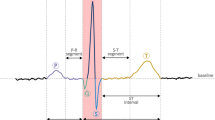Abstract
The human heart is a complex system that reveals many clues about its condition in its electrocardiogram (ECG) signal, and ECG supervising is the most important and efficient way of preventing heart attacks. ECG analysis and recognition are both important and tempting topics in modern medical research. The purpose of this paper is to develop an algorithm which investigates kernel method, locally linear embedding (LLE), principal component analysis (PCA), and support vector machine(SVM) algorithms for dimensionality reduction, features extraction, and classification for recognizing and classifying the given ECG signals. In order to do so, a nonlinear dimensionality reduction kernel method based LLE is proposed to reduce the high dimensions of the variational ECG signals, and the principal characteristics of the signals are extracted from the original database by means of the PCA, each signal representing a single and complete heart beat. SVM method is applied to classify the ECG data into several categories of heart diseases. Experimental results obtained demonstrated that the performance of the proposed method was similar and sometimes better when compared to other ECG recognition techniques, thus indicating a viable and accurate technique.



Similar content being viewed by others
References
Lathauwer LD, Moor BD, Vandewalle JF (2000) Electrocardiogram extraction by blind source subspace separation. IEEE Trans Biomed Eng 47(5):567–572
Hu YH, Palreddy S, Tompkins WJ (1997) A Patient-adaptable ECG beat classifier using a mixture of experts approach. IEEE Trans Biomed Eng 44(9):891–900
Fahoum AS, Howitt I (1999) Combined wavelet transformation and radial basis neural networks for classifying life-threatening cardiac arrhythmias. Med Biol Eng Comput 37:566–573
Chawla MPS, Verma HK, Vinod K (2006) Independent component analysis: a novel technique for removal of artifacts and base-line wander in ECG. Proc. national conference, CISCON-2006 MIT, Manipal, India, pp 14–8
Zhang H, Zhang LQ (2005) ECG analysis based on PCA and support vector machines. IEEE Trans 743–747
Schölkopf B, Smola A, Müller KR (1998) Nonlinear component analysis as a kernel eigenvalue problem. Neural Comput 10(5):1299–1319
Roweis ST, Saul LK (2000) Nonlinear dimensionality reduction by locally linear embedding. Science 290:2323–2326
Jollife IT (1986) Principal component analysis. Springer-Verlag, New York
Vapnik VN (1998) Statistical learning theory. Wiley, New York, pp 157–169
Schölkopf B, Smola AJ (2002) Learning with kernels. MIT Press, Cambridge
Wang XC, Paliwal KK (2003) Feature extraction and dimensionality reduction algorithms and their applications in vowel recognition, Pergamon. J Pattern Recognit Soc 36:2429–2439
Haykin S (1999) Neural networks: a comprehensive foundation. Practice-Hall, New Jersey, pp 330–332
Cristianini N, Shawe-Talyor J (2000) An introduction to support vector machines. Cambridge Uninversity Press, Cambridge, pp 96–98
Klir GJ, Bo Y (1995) Fuzzy sets and fuzzy logic: theory and applications. Englewood Cliffs, Prentice-Hall pp 172–177
Vapnik VN (1995) The nature of statistical learning theory. Springer-Verlag, New York
Qian Z, Cai YD, Li Y (2006) A novel computational method to predict transcription factor DNA binding preference. Biochem Biophys Res Commun 348:1034–1037
Du PF, He T, Li YD (2007) Prediction of C-to-U RNA editing sites in higher plant mitochondria using only nucleotide sequence features. Biochem Biophys Res Commun 358:336–341
Feng KY, Cai YD, Chou KC (2005) Boosting classifier for predicting protein domain structural class. Biochem Biophys Res Commun 334:213–217
Vapnik VN (1999) An overview of statistical learning theory. IEEE Trans Neural Netw 10(5):988–999
Shawe-Talyor J, Cristianini N (2004) Kernel methods for pattern analysis. Cambridge Uninversity Press, Cambridge
Saul L, Roweis S (2002) Think globally, fit locally: unsupervised learning of nonlinear manifolds. Technical report MS CIS-02-18, University of Pennsylvania 37:134–135
Alessandro MD et al (2003) Epileptic seizure prediction using hybrid feature selection over multiple intracranial EEG electrode contacts: a report of four patients. IEEE Trans Biomed Eng 50(5):603–615
Tu C, Zeng Y, Yang X (2004) Nonlinear processing and analysis of ECG data. In: Technology and health care. IOS Press, Amsterdam, pp 1–9
Clayton RH, Murray A, Campbell RWF (1994) Frequency analysis of selfterminating ventricular fibrillation. Comput Cardiol 27:705–708
Bernat EM, Williams WJ, Gehring WJ (2005) Decomposing ERP timefrequency energy using PCA. Clin Neurophysiol 116:1314–1334
Engin M, Demirag S (2003) Fuzzy-hybrid neural network based ECG beat recognition using three different types of feature set. Cardiovasc Eng 3(2):1–80
Kemal P, Salih G (2007) Detection of ECG Arrhythmia using a differential expert system approach based on principal component analysis and least square support vector machine. Appl Math Comput 186:898–906
Fawcett F (2006) An introduction to ROC analysis. Pattern Recognit Lett 27(8):861–874
Acknowledgments
This work is supported by Foundation of National Natural science No. 10671030.
Author information
Authors and Affiliations
Corresponding author
Rights and permissions
About this article
Cite this article
Li, X., Shu, L. & Hu, H. Kernel-based nonlinear dimensionality reduction for electrocardiogram recognition. Neural Comput & Applic 18, 1013–1020 (2009). https://doi.org/10.1007/s00521-008-0231-1
Received:
Accepted:
Published:
Issue Date:
DOI: https://doi.org/10.1007/s00521-008-0231-1




